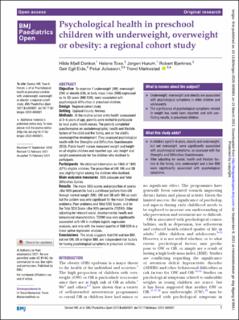| dc.contributor.author | Donkor, Hilde Mjell | |
| dc.contributor.author | Toxe, Helene | |
| dc.contributor.author | Hurum, Jørgen | |
| dc.contributor.author | Bjerknes, Robert | |
| dc.contributor.author | Eide, Geir Egil | |
| dc.contributor.author | Juliusson, Pétur Benedikt | |
| dc.contributor.author | Markestad, Trond Jacob | |
| dc.date.accessioned | 2023-10-31T14:28:56Z | |
| dc.date.available | 2023-10-31T14:28:56Z | |
| dc.date.created | 2021-07-15T12:24:31Z | |
| dc.date.issued | 2021 | |
| dc.identifier.citation | BMJ Paediatrics Open. 2021, 5 (1), . | en_US |
| dc.identifier.issn | 2399-9772 | |
| dc.identifier.uri | https://hdl.handle.net/11250/3099813 | |
| dc.description.abstract | Objective To examine if underweight (UW), overweight (OW) or obesity (OB), or body mass index (BMI) expressed as its SD score (BMI SDS), were associated with psychological difficulties in preschool children. Design Regional cohort study. Setting Oppland County, Norway. Methods At the routine school entry health assessment at 5–6 years of age, parents were invited to participate by local public health nurses. The parents completed questionnaires on sociodemographic, health and lifestyle factors of the child and the family, and on the child’s neurocognitive development. They assessed psychological health with the Strengths and Difficulties Questionnaire (SDQ). Public health nurses measured weight and height on all eligible children and reported age, sex, height and weight anonymously for the children who declined to participate. Participants We obtained information on 1088 of 1895 (57%) eligible children. The proportion of UW, OW and OB was slightly higher among the children who declined. Main outcome measures SDQ subscale and Total Difficulties Scores. Results The mean SDQ scores and proportion of scores ≥the 90th percentile had a curvilinear pattern from UW through normal weight (NW), OW and OB with NW as nadir, but the pattern was only significant for the mean Emotional problems, Peer problems and Total SDQ Scales, and for the Total SDQ Score ≥the 90th percentile (TDS90). After adjusting for relevant social, developmental, health and behavioural characteristics, TDS90 was only significantly associated with UW in multiple logistic regression analyses, and only with the lowest quartile of BMI SDS in a linear spline regression analysis. Conclusions The study suggests that UW and low BMI, but not OW, OB or higher BMI, are independent risk factors for having psychological symptoms in preschool children. http://creativecommons.org/licenses/by-nc/4.0/ This is an open access article distributed in accordance with the Creative Commons Attribution Non Commercial (CC BY-NC 4.0) license, which permits others to distribute, remix, adapt, build upon this work non-commercially, and license their derivative works on different terms, provided the original work is properly cited, appropriate credit is given, any changes made indicated, and the use is non-commercial. See: http://creativecommons.org/licenses/by-nc/4.0/. | en_US |
| dc.description.sponsorship | The study was supported by grants from The South-Eastern Norway
Regional Health Authority (Helse Sør Øst) and Innlandet Hospital Trust. Grant
number not applicable. | en_US |
| dc.language.iso | eng | en_US |
| dc.relation.uri | https://bmjpaedsopen.bmj.com/content/bmjpo/5/1/e000881.full.pdf | |
| dc.rights | Navngivelse-Ikkekommersiell 4.0 Internasjonal | * |
| dc.rights.uri | http://creativecommons.org/licenses/by-nc/4.0/deed.no | * |
| dc.title | Psychological health in preschool children with underweight, overweight or obesity: A regional cohort study | en_US |
| dc.type | Peer reviewed | en_US |
| dc.type | Journal article | en_US |
| dc.description.version | publishedVersion | en_US |
| dc.rights.holder | This is an open access article distributed in accordance with the Creative Commons Attribution Non Commercial (CC BY-NC 4.0) license, which permits others to distribute, remix, adapt, build upon this work non-commercially, and license their derivative works on different terms, provided the original work is properly cited, appropriate credit is given, any changes made indicated, and the use is non-commercial. See: http://creativecommons.org/licenses/by-nc/4.0/. | en_US |
| dc.source.pagenumber | 7 | en_US |
| dc.source.volume | 5 | en_US |
| dc.source.journal | BMJ Paediatrics Open | en_US |
| dc.source.issue | 1 | en_US |
| dc.identifier.doi | 10.1136/bmjpo-2020-000881 | |
| dc.identifier.cristin | 1921838 | |
| cristin.ispublished | true | |
| cristin.fulltext | original | |
| cristin.qualitycode | 1 | |

